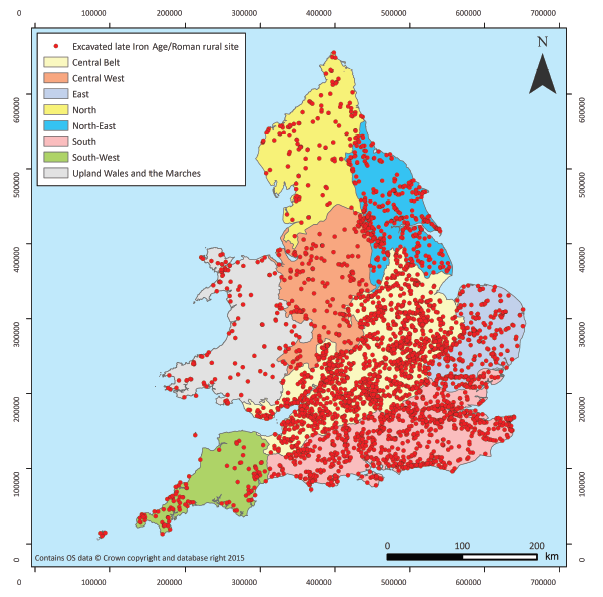The Rural Settlement of Roman Britain: an online resource
Martyn Allen, Nathan Blick, Tom Brindle, Tim Evans, Michael Fulford, Neil Holbrook, Lisa Lodwick, Julian D Richards, Alex Smith, 2015. (updated 2018) https://doi.org/10.5284/1030449. How to cite using this DOI
Data copyright © University of Reading unless otherwise stated
This work is licensed under the ADS Terms of Use and Access.
Primary contact
Prof
Michael
Fulford
Professor of Archaeology
School of Archaeology, Geography and Environmental Science
University of Reading
Whiteknights
PO Box 218
Reading
RG6 6AA
England
Tel: 0118 3788048
Resource identifiers
- ADS Collection: 1352
- DOI:https://doi.org/10.5284/1030449
- How to cite using this DOI
Introduction
This resource brings together the excavated evidence for the rural settlement of Roman Britain with the over-arching aim to inform a comprehensive reassessment of the countryside of Roman Britain. It includes both traditionally published reports and 'grey literature' reports from developer-funded excavations since 1990.
The project arose from pilot projects undertaken by Cotswold Archaeology1 and funded by Historic England and it began in 2012. It is funded by grants from the Leverhulme Trust to the Universities of Reading and York (ADS)2 and from Historic England to Cotswold Archaeology.3
This final phase (December 2016) publishes the complete settlement evidence from Roman England and Wales, together with the related finds, environmental and burial data. These are produced alongside a series of integrative studies on rural settlement, economy, and people and ritual, published by the Society for the Promotion of Roman Studies as Britannia Monographs. The first volume, on rural settlement, has now been published, while the two remaining volumes will be released in 2017 and 2018.

With the inclusion of the Welsh settlement data in 2015 to complement that from England, we now have some 3600 records of rural sites, accounting for c. 2500 individual settlements, the vast majority of which were reported on since the implementation of PPG 16 in 1990. However the project has reached back and includes some sites published as early as 1808. Each site is described with bibliographic entries, as well as information on chronology, settlement type, morphological form and associated material culture and environmental data. The project has not included all investigations, such as watching briefs and small-scale evaluations producing Roman evidence, but has limited its scope to those that have yielded plan, chronology and quantified finds data susceptible of characterisation and synthesis. The cut-off for inclusion here is publication before 31st December 2014 for sites in England and March 2015 for sites in Wales.
'Grey Literature': with the agreement of the parties concerned including the 88 HER/SMR/UAD consulted as part of this project, the reports accessed for this project have been scanned and made available through the ADS.

1
Cotswold Archaeology 2008. Assessing the Research Potential of Grey literature in the Study of Roman England. Stage 1 Report. Cirencester; doi:10.5284/1000418
Cotswold Archaeology 2009. Assessing the Research Potential of Grey Literature in the Study of Roman England. Stage 2 Report. Cirencester; doi:10.5284/1000418
M. Fulford and N. Holbrook, 'Assessing the Contribution of Commercial Archaeology to the Study of the Roman Period in England, 1990-2004', Antiquaries Journal 91 (2011), 323-345.
2 Leverhulme RPG-417: 'Evaluation of PPG 16, 'grey' literature and the rural settlement of Roman Britain' 2012-15; RPG-2014-227: 'From Roman England to Roman Britain: rural settlement, society and economy' 2015-17.
3 English Heritage: 'Assessing Grey Literature in the Study of Roman England 2011-2014', 2012-17.








